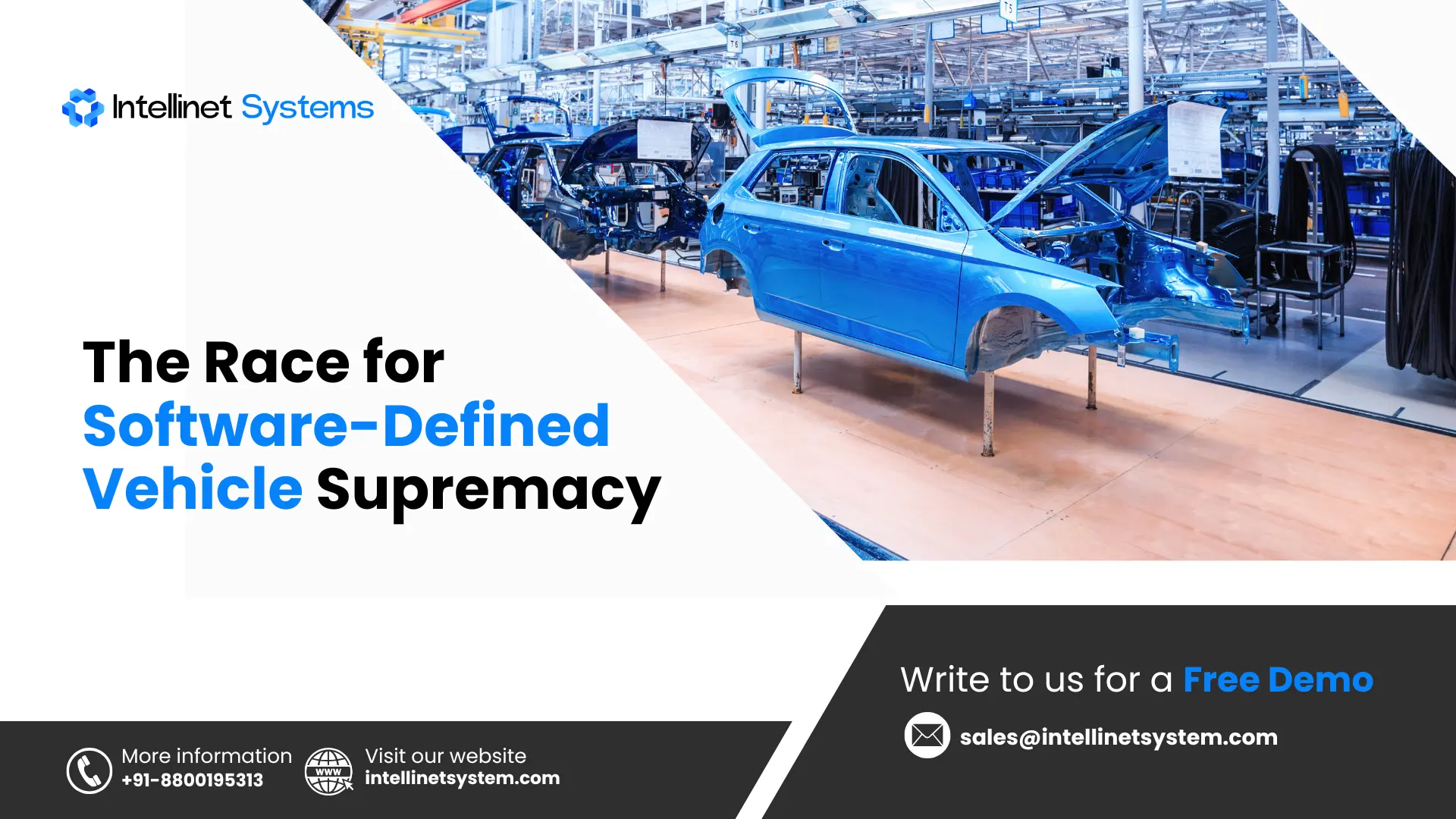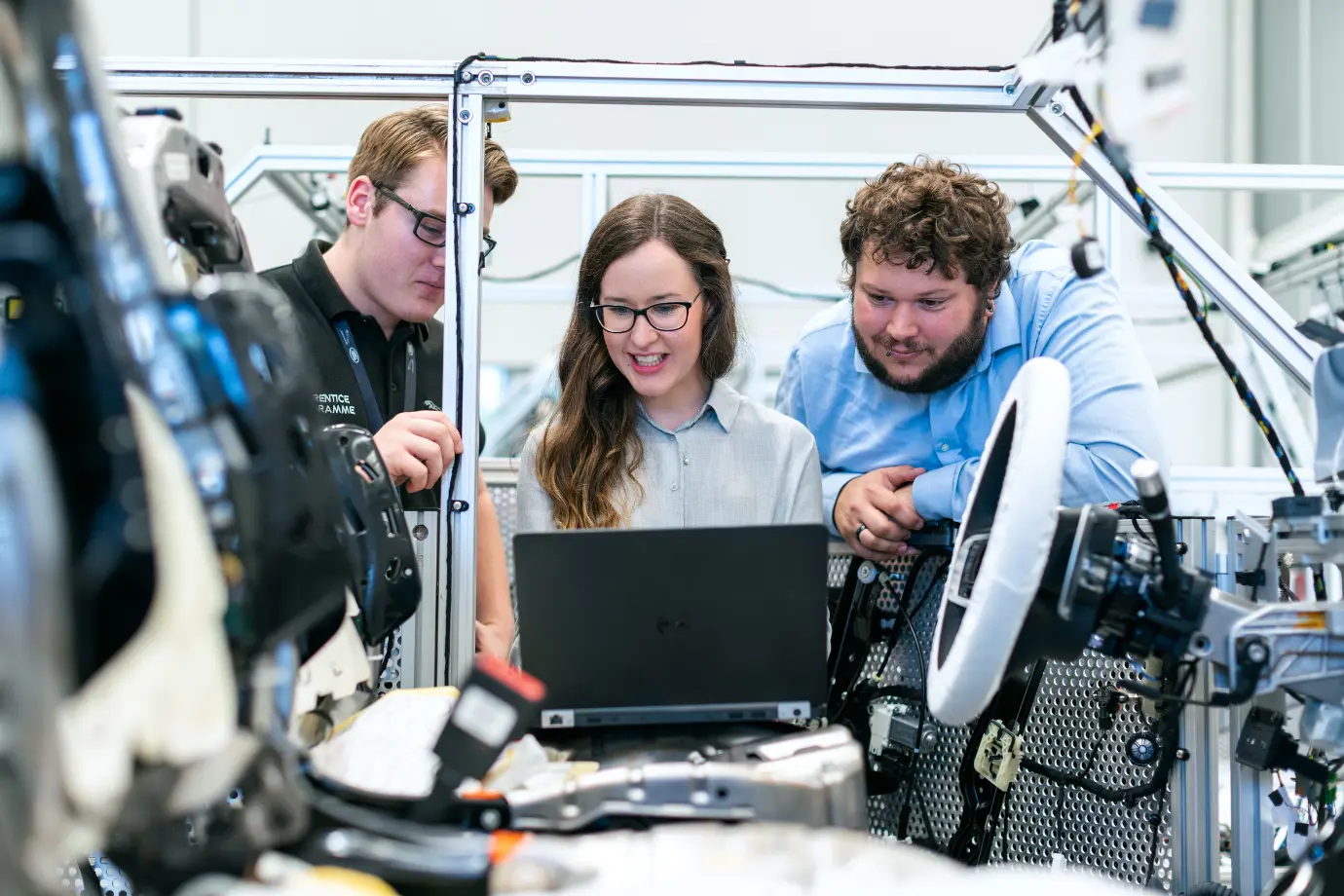
Picture a car that learns your quirks and adapts itself to your driving style without a mechanic’s intervention. Software-defined vehicles (SDVs) make this real, using software to run key functions like driving, safety, and entertainment systems.
Unlike the old vehicle models that depend on static hardware, SDVs use wireless updates to catch hazards faster than any technician, adapt to your preferences, and stretch the EV battery life to cut emissions. USA’s technological power, Europe's regulatory expertise, and China's manufacturing strength are competing to own the SDV future.
More than simply automobiles, they are platforms for new revenue streams, like data-driven services and subscriptions, which provide the OEMs a significant competitive advantage in the global auto market. However, OEMs have to cope with challenging obstacles, such as complex software integrations, cyber threats, and country-specific regulations.
Through this blog, let’s explore the potential SDVs hold, the challenges and opportunities they present for automotive OEMs, and the reasons behind the high-stakes competition between China, Europe, and the United States.
What are Software-Defined Vehicles (SDVs)?
.webp)
Traditional cars depend on hardware for basics like braking and steering, and are comprised of fixed wires and separate control units. Software-defined vehicles turn that chaos on its head.
SDVs put software at the core, from acceleration to your favorite music, with an agility that standard automobiles couldn't match. More than just a new feature, it's a completely new approach to vehicle design.
Technologies that power SDVs include:
- Sensing and Perception: Lidar, radar, sonar, IMUs, and GNSS/GPS, paired with high-definition maps, provide real-time environmental data and enable safe autonomous navigation.
- Connectivity and Communication: Vehicle-to-everything (V2X) systems, 5G networks, and cloud integration enable vehicles to share data with infrastructure and each other.
- Computing and Processing: Centralized platforms, high-performance computing, AI, machine learning, and edge computing handle complex data for instant decisions.
- Software and Systems: Embedded operating systems, Over-the-air (OTA) updates, and service-oriented architecture ensure flexible, scalable functionality, a stark contrast to 1990s hardware fixes.
- Cybersecurity and Safety Measures: Secure Boot, HSMs, data encryption, IDS, and secure protocols protect against threats, critical after the cybersecurity scares that came with early connected systems.
- Other Technologies: Advanced battery technology and axial-flux motors boost EV efficiency.
In the early 2000s, technicians had to deal with bolted-on GPS devices, but SDVs have made that obsolete. This is enabling automotives to evolve years after purchase and opening up opportunities for informed services.
How SDVs Are Creating a Buzz in the Automotive Industry

Today, SDVs are a big name in the automobile industry, and the hype is intense. They are redefining how automotive OEMs compete, bringing innovation that leaves traditional auto manufacturing behind. Leaner designs save costs, while features like dashboards that learn your routes keep drivers delighted.
The figures back up the hype: the SDV market was valued at USD 213.5 billion in 2024, and MarketsandMarkets projects it will surge to USD 1,237.6 billion by 2030, growing at a CAGR of 34%.
It's more than simply revenue. SDVs use ADAS to make roadways safer and reduce collisions. They reduce pollution with smarter electric automobiles.
They provide mobility to people like the elderly using self-driving technology. CES 2025 was a carnival of zonal architectures and GenAI, simplifying automobiles and making features easier to deploy.
Back in 2001, telematics was a hype. But today, SDVs overshadow that by spawning subscriptions and data services. Sonatus’ 2025 survey says zonal designs will rule by 2030 and ease vehicle complexity.
But without standard processes, OEMs may face challenges in integration that can stall operations. For OEMs, this buzz is your signal: adopt automotive technology trends to generate value, but be prepared for the grind of growing SDVs in the global automotive sector.
What are the Driving Forces for the Global SDV Battle?

The SDV race is a global street fight that is fueled by technology, investments, and what drivers demand. China, Europe, and the U.S. are scrapping for the top spot globally. Here are the top factors that are driving this shift:
Technological Innovations
Advancing technology is the primary driving force of the SDV shift globally. AI and deep learning allow SDVs to crunch data for safer self-driving, making calls no human could. Over-the-air updates keep cars up-to-date, adding features like your phone gets apps, which are the foundation for smart cars.
Economic Incentives
Cash keeps it rolling. SDVs shift from one-time sales to steady revenue streams, such as subscriptions for better navigation or power boosts. Continuing the drift of connected vehicles that generate profits through service upgrades, SDVs are expanding opportunities to create continuous earnings.
Consumer Demand
Drivers want cars that cater to their comfort and convenience. The shift in demand toward smart cars with custom settings, like adaptive seats or curated playlists, is trending, driving SDVs into the future of mobility.
Regulatory and Policy Support
Changing regulations and region-specific approaches set the stage for the shift. China’s subsidies supercharge EV and SDV growth. Europe’s tough safety laws pave the way for ADAS. The U.S.’s Inflation Reduction Act fuels innovation.
But automakers, tech firms, and governments need standards like the Eclipse Foundation to streamline this shift and avoid a mess. OEMs must bridge these gaps to scale SDVs in the global automotive industry.
Why is China a Powerhouse of the SDV Race?

China’s SDV supremacy is significant. Massive government subsidies have fueled the growth of electric vehicles and smart automobiles, transforming China into a hub for automotive software advances. Policies encourage local players to innovate quickly, and they aren't messing around.
Baidu, Huawei, and manufacturers like BYD are offering advanced technologies today. These technologies include voice assistants that predict your next move, parking systems that don't require your presence, and cockpits that are personalized to your preferences. These resonate with China's tech-savvy drivers, becoming a worldwide norm.
Strengths
- China has expertise. Its enormous home market drives demand, while its manufacturing competence, developed over decades, delivers at scale.
- Ten Chinese companies developing driverless vehicles in California demonstrate their global reach.
- Hyundai's new AI R&D unit in China seals the deal by integrating cutting-edge technology into production processes.
- Data-driven improvements altered aftermarket services ten years ago, and China is doing it again.
Challenges
- R&D spending, while up, doesn’t match China’s scale, limiting big leaps. Rural infrastructure lags, slowing SDV rollout across the board.
- Although Chinese manufacturers outperformed the competition in the 2000s, today's pace is faster.
- Cybersecurity threats exist, and global standards are required to compete internationally.
- Although NIO and Xiaomi are using driver data to improve software and are high on Wards Intelligence's 2025 SDV rankings, Tesla still tops the list.
- OEMs must protect cybersecurity when collaborating with China's tech giants.
Europe’s Push for SDV Leadership

Europe’s SDV pursuit builds on its car-making legacy. Giants like Volkswagen and Bosch are investing heavily in vehicle software and artificial intelligence (AI) in order to achieve safe, environmentally friendly transportation. The European Union’s General Safety Regulation promotes electric vehicles and advanced driver-assistance systems, setting a high bar.
Strength
- Teamwork is Europe’s competitive edge. Europe holds leadership in establishing trust via robust cybersecurity, which is essential for SDVs.
- The Volkswagen-Bosch Automated Driving Alliance advances self-driving technology.
- The Eclipse Foundation's 2025 European SDV Ecosystem Summit promotes open innovation. These innovations enable connected vehicles to function seamlessly.
Challenges
- Complex laws have a significant impact on smaller OEMs, with compliance costs depleting budgets. It's a challenge that requires significant funds.
- To match the global pace, European OEMs must reduce regulations and expand platforms.
- Their green emphasis is ideal for electric cars, but agility will determine Europe’s place in the future of mobility.
The U.S. Drive for SDV Dominance

The U.S. is a titan in the SDV race, propelled by persistent technological innovation. Tesla, Waymo, and Nvidia are rewriting autonomous driving and automotive software to create global standards.
Strengths
- Consumer demand for connected vehicles and semi-autonomous features, backed by the Inflation Reduction Act, drives growth.
- The USA is leading the way in driverless vehicles, as seen by Waymo's 150,000 weekly paid rides.
- Tesla maintains a top position in Wards Intelligence's SDV rankings in 2025.
Challenges
- State-by-state restrictions produce a disorganized patchwork that slows rollouts.
- Startups confront heavy R&D costs, which limit their reach.
Challenges and Opportunities in SDV Development

For OEMs, software-defined cars provide both major challenges and innovative possibilities. Just as telematics previously rocked the market, technological changes do the same, but SDVs raise the stakes.
Challenges
Let’s have a look at the challenges OEMs face in developing SDVs:
- Cybersecurity risks: Connected vehicles are a paradise for hackers, where one security lapse might destroy a driver's trust.
- Regulatory assortment: Regulations vary widely across regions. For example, Europe's Euro NCAP requires physical inspections, while other regulations do not, which makes international rollouts difficult.
- Public skepticism: Self-driving technology scares drivers after crashes hit the news, creating a trust gap that is tough to overcome.
- Integration problems: Creating software that works well across platforms is difficult and demands time and expertise.
- Costly expertise: Employing AI and security experts burns capital, a hurdle that might sink early startups.
Opportunities
- Greener vehicles: Software changes increase EV range while reducing emissions. This trend picked up steam during the 2015 EV boom.
- Revenue from subscriptions: Unlike one-time sales, OTA updates and services like premium navigation generate consistent income.
- Faster innovation: Centralized systems have revolutionized innovation by reducing costs and expediting feature rollouts.
- Driver fulfillment: Customized settings, such as playlists and seats, satisfy customer preferences and increase loyalty.
Global Implications
- Broader mobility access for all: Self-driving tech opens transportation to seniors and disabled individuals, a change since early accessibility projects.
- Fewer crashes: According to IIHS statistics, ADAS like automated emergency braking reduces front collisions by up to 50% and saves the lives of millions.
- Healthier urban communities: Less pollution and noise from efficient SDVs improve city life and echo early green initiatives.
Ongoing Government Initiatives for the Adoption of SDVs in Emerging Markets Globally

Emerging markets are pivotal in the global SDV race, with governments deploying strategic initiatives to advance infrastructure and adoption. Similar to telematics projects during the 2000s rolling out in developing regions, today’s SDV initiatives echo that ambition through the impact of policy-driven innovation.
Here is how government policies in emerging markets are accelerating SDV integration:
India
The FAME II scheme of 2019 subsidizes EV infrastructure, mandating localization for SDV-enabled electric models. The Production Linked Incentive (PLI) scheme supports battery and component manufacturing, fostering software integration. A 5% GST rate on EVs incentivizes adoption, while the PM E-DRIVE policy launched in 2024 allocates $1.3 billion for electric vehicles, including SDV-equipped buses. States like Karnataka offer R&D and infrastructure funds for SDV projects.
Indonesia
The expansion of SDV-equipped EVs in Indonesia is fueled by a 2023 VAT cut from 11% to 1%. In line with a 2030 target of 2 million EVs, tax incentives for enterprises that commit to local production prioritize software-driven systems. Plans for 30,000 charging stations and smart city projects enable V2X connectivity and robust cybersecurity frameworks.
Brazil
Launched in 2024, Brazil's MOVER initiative finances R&D for SDVs and sustainable cars. A planned 2060 ban on fossil fuels and a deliberate change in import duties encourage domestic SDV production. Electrocenters further stabilize grids for connected vehicles and energy projects.
South Africa
A 2025 public fleet mandate shifts 5% resources to cleaner fuels with 2% annual increases. This is helping manufacturers to integrate SDV technologies for efficiency in fleet management projects.
Mexico
Mexico’s COP26 pledge for 100% zero-emission sales by 2040 promotes the development of SDVs. Fleet mandates and 2024 tariff adjustments drive local SDV production and align Mexico with global trends.
Final Words
The SDV race is reshaping the automotive world. China’s scale, Europe’s precision, and America’s innovation are fighting to own the future of mobility. SDVs aren’t just automotives, they’re platforms for safer roads, greener energy, and rides that feel more personalized. OEMs, policymakers, and drivers must embrace the current trends in automotive technology.
A successful SDV roll-out requires automotive OEMs to establish collaborations, create strong channels, and gain drivers' trust. To make SDVs work for everyone, strike a balance between bold actions and ethical and legal considerations. The future requires vision, so take the lead.
Explore More Insights
About the Author

Chandra Shekhar
Chandra Shekhar is the Senior Manager, Strategy & Business Development at Intellinet Systems. With over a decade of experience in the automotive industry, Chandra Shekhar has led digital transformation and aftersales strategy initiatives for OEMs across multiple markets. His background combines deep industry knowledge with a practical understanding of how technology can solve real operational challenges. He focuses on making complex ideas clear and relevant for automotive and aftermarket professionals navigating ongoing change.
























